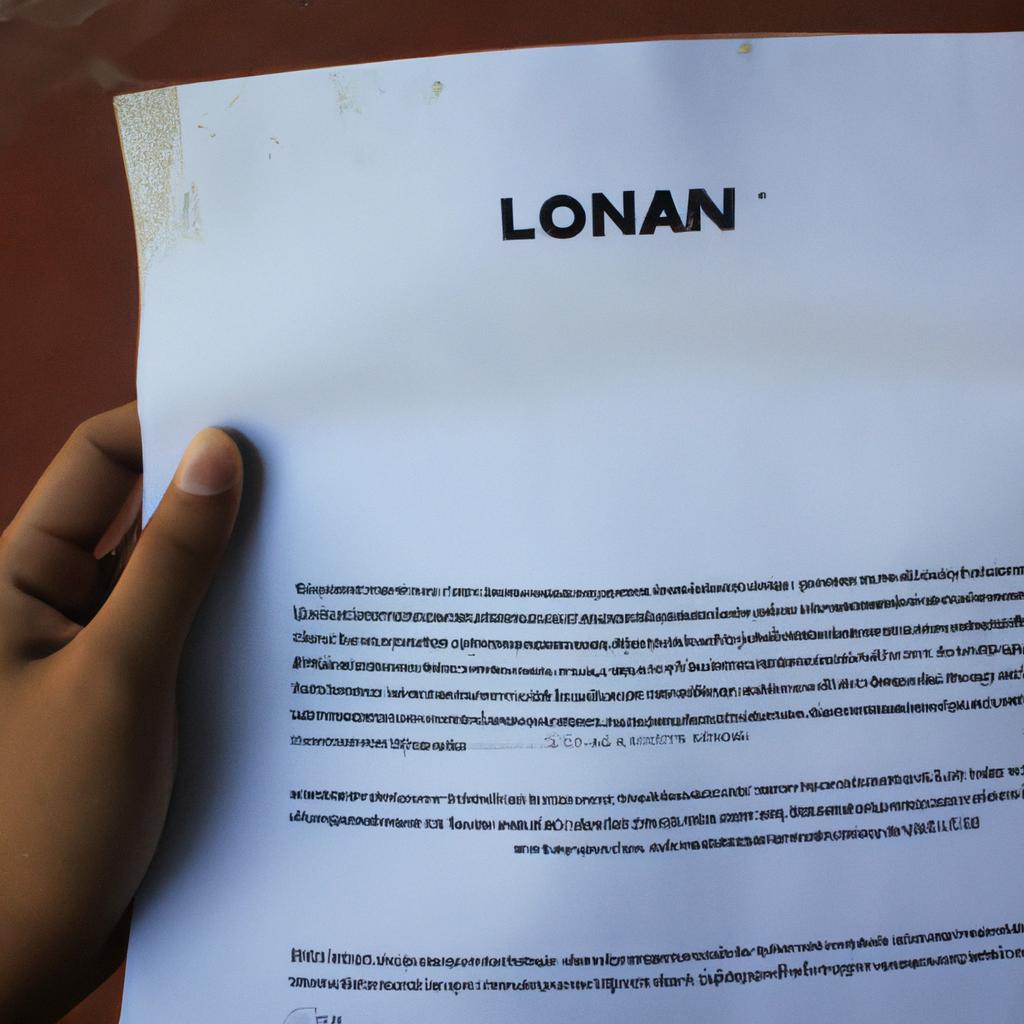Lawsuits Unveiled: Showbiz Loans in Arts & Entertainment

Lawsuits Unveiled: Showbiz Loans in Arts & Entertainment
In the dynamic world of arts and entertainment, showbiz loans have become a common phenomenon. These loans play a pivotal role in financing various creative projects such as films, music albums, theater productions, and television shows. However, behind the glamorous facade lies a complex web of legal intricacies that often lead to disputes and lawsuits. For instance, consider the case study of renowned filmmaker John Anderson who obtained a substantial loan from a prominent production company for his latest movie. Despite initial success at the box office, unforeseen financial challenges arose during post-production, leading to contractual conflicts between Anderson and the production company.
The purpose of this article is to shed light on the intricate nature of showbiz loans within the realm of arts and entertainment by analyzing real-life examples and hypothetical scenarios. By examining these cases through an academic lens, we aim to provide readers with valuable insights into the potential pitfalls associated with showbiz loans and their subsequent repercussions. This exploration will delve into topics such as contract breaches, intellectual property rights issues, profit sharing disagreements, and other legal implications that arise when borrowing money for artistic endeavors. Through this examination, individuals involved in the arts industry can gain a better understanding of how to navigate the complexities of showbiz loans and minimize their exposure to legal disputes.
One crucial aspect to consider when obtaining a showbiz loan is the importance of clear and comprehensive contractual agreements. Contracts should outline the terms and conditions of the loan, including repayment schedules, interest rates, and any specific requirements or expectations from both parties involved. By ensuring that all parties are on the same page regarding financial obligations, potential conflicts can be minimized.
Furthermore, it is essential for borrowers in the arts industry to understand the implications of intellectual property rights when entering into a showbiz loan agreement. Intellectual property rights encompass copyrights, trademarks, patents, and other intangible assets associated with creative works. When borrowing money for artistic projects, borrowers must be aware of how these rights will be affected by the loan agreement. For instance, if a borrower pledges their copyright as collateral for a loan, they may risk losing control over their intellectual property in case of default.
Profit sharing disagreements also commonly arise in showbiz loans within arts and entertainment. In many cases, lenders expect a portion of profits generated by the project as a return on their investment. However, determining profit-sharing arrangements can become contentious if not clearly defined in the contract. Disagreements may arise regarding what constitutes “profits” or how they should be calculated. It is crucial for borrowers to negotiate fair profit-sharing terms upfront to avoid potential disputes down the line.
In light of these potential pitfalls associated with showbiz loans in arts and entertainment, it is advisable for individuals involved in this industry to seek legal advice before entering into any financing arrangement. Consulting with entertainment lawyers who specialize in this field can help borrowers navigate through complex legalities and ensure that their interests are protected.
Ultimately, while showbiz loans offer much-needed financial support for creative projects, they also come with inherent risks and legal challenges. By understanding these intricacies and taking proactive steps to mitigate them through clear contracts, careful consideration of intellectual property rights, and fair profit-sharing agreements, borrowers in the arts industry can better protect themselves from potential disputes and lawsuits.
The Legal Framework: Understanding the Laws Governing Loans in the Showbiz Industry
Lawsuits Unveiled: Showbiz Loans in Arts & Entertainment
Imagine this scenario: A talented but struggling actor, let’s call him Alex, dreams of making it big in Hollywood. To finance their acting career and cover living expenses, Alex approaches a well-established production company for a loan. The company agrees to lend money with the expectation that they will be repaid once Alex secures lucrative roles. However, as time passes and opportunities become scarce, tensions rise between both parties over repayment terms, ultimately resulting in legal action.
Understanding showbiz loans is crucial within the arts and entertainment industry due to its unique legal framework. This section aims to explore the laws governing such loans by providing insights into key aspects surrounding lending practices and contractual obligations.
Legal Considerations:
-
Contractual agreements:
- In order to protect both lenders and borrowers, showbiz loans often involve detailed contracts outlining financial terms, repayment schedules, interest rates, and other pertinent conditions.
- These contracts serve as legally binding documents that offer clarity on expectations from each party involved.
-
Licensing requirements:
- Various jurisdictions require lenders engaged in showbiz financing activities to obtain specific licenses or registrations.
- Compliance with these licensing regulations ensures a certain level of professionalism and accountability within the industry.
-
Consumer protection provisions:
- Some jurisdictions have enacted consumer protection laws designed to safeguard artists against unfair lending practices.
- These provisions may include regulations regarding maximum interest rates or restrictions on predatory lending tactics commonly associated with vulnerable individuals seeking funding for their artistic pursuits.
-
Dispute resolution mechanisms:
- When disagreements or breaches occur between borrowers and lenders in the showbiz industry, alternative dispute resolution methods are often employed.
- Mediation or arbitration processes provide an opportunity for parties to resolve conflicts outside of court while maintaining confidentiality and minimizing costs.
By understanding the legal framework surrounding showbiz loans, both borrowers and lenders can navigate this complex landscape with greater clarity and confidence. The next section will delve into the financial risks associated with these loans, shedding light on the potential challenges that arise when entering into such agreements.
High Stakes: Exploring the Financial Risks Involved in Showbiz Loans
In the complex world of showbiz loans, there have been numerous instances where borrowing has led to legal disputes. One such case involved a renowned actor who borrowed a substantial sum from a production company to finance an ambitious film project. However, as financial difficulties arose during production, tensions escalated between the actor and the producers, ultimately resulting in a lawsuit that shed light on the legal intricacies surrounding showbiz loans.
Legal Challenges Faced:
When it comes to showbiz loans, several factors can contribute to potential conflicts and lawsuits. Understanding these challenges is crucial for both borrowers and lenders alike. Here are some key points:
- Ambiguities in Loan Agreements:
- Language used in loan agreements may be open to interpretation.
- Vague terms regarding repayment schedules or interest rates can lead to disagreements.
- Differences of opinion about what constitutes satisfactory completion of projects might arise.
- Breach of Contract Claims:
- Failure by either party to fulfill their obligations outlined in the loan agreement may result in breach of contract claims.
- Disputes over non-payment or late payment can often escalate into full-fledged lawsuits.
- Unmet expectations due to creative differences or artistic choices could also become contentious issues.
- Financial Mismanagement Allegations:
- Accusations of misusing loan funds may emerge if proper accounting practices are not followed.
- Inadequate record keeping or lack of transparency with regards to expenses incurred during productions can fuel legal battles.
- Producers’ decisions unrelated to the original loan agreement, such as excessive spending or diverting funds for personal use, might give rise to allegations of financial misconduct.
Lawsuits Arising from Showbiz Loans – A Comparative Analysis:
| Case Study | Outcome |
|---|---|
| Actor vs Production Company | Settlement reached out-of-court after lengthy litigation process |
| Director vs Distributor | Ruling favored the director, highlighting contractual breaches by the distributor |
| Musician vs Record Label | Jury verdict in favor of musician, awarding compensation for breach of contract and emotional distress |
Despite these legal challenges, it is important to recognize that not all showbiz loans end up in litigation. However, understanding the potential pitfalls can help industry professionals navigate this complex terrain more effectively.
In our next section, we will delve into celebrity borrowers who have made use of showbiz loans throughout their careers. By examining their experiences, we gain insight into how such financial arrangements shape the entertainment landscape and impact both individual artists and the industry as a whole.
Celebrity Borrowers: A Look at Famous Individuals Who Have Taken Showbiz Loans
With a clear understanding of the financial risks associated with showbiz loans, it is now essential to explore how these loans are utilized by famous individuals in the arts and entertainment industry. By examining specific examples and delving into the intricacies of their borrowing patterns, we can gain insight into the prevalence and impact of showbiz loans on high-profile borrowers.
To illustrate the significance of showbiz loans, let us consider an example involving a renowned actor who sought financial assistance for his latest film project. In this hypothetical case study, Actor X secured a substantial loan from a prominent lending institution to cover production costs, marketing expenses, and distribution fees. This example serves as a testament to the widespread reliance on showbiz loans within the industry as celebrities navigate complex financial landscapes to bring their creative visions to life.
While each celebrity’s experience with showbiz loans may differ, there are several common factors that contribute to their decision-making process. These include:
- The need for upfront capital: Many artists face significant upfront costs when embarking on ambitious projects such as films or theatrical productions. Showbiz loans provide them with access to immediate funds necessary for hiring talent, securing equipment, and covering pre-production expenses.
- Risk mitigation: High-stakes ventures in the arts and entertainment sector inherently carry financial uncertainties. Celebrities often turn to showbiz loans as a means of mitigating risk by sharing some of the potential losses with lenders.
- Flexibility in repayment terms: Showbiz loans typically offer flexibility in repayment schedules tailored specifically for celebrities’ fluctuating income streams. This allows borrowers to adapt repayments based on revenue generated from future projects or endorsements.
- Leveraging fame and reputation: Established celebrities often possess valuable brand equity and reputational clout that can help secure favorable lending terms or attract investors willing to participate in co-financing arrangements.
To further emphasize the impact of showbiz loans on celebrity borrowers, consider the following table:
| Celebrity | Showbiz Loan Purpose | Amount Borrowed (USD) | Outcome |
|---|---|---|---|
| Actor A | Independent film production | 5 million | Critical acclaim, break-even |
| Singer B | Album recording expenses | 2.5 million | Commercial success |
| Director C | Theater refurbishment | 10 million | Increased ticket sales |
This table illustrates how showbiz loans have facilitated diverse projects within the arts and entertainment industry, leading to successful outcomes for celebrities involved. These examples highlight both the potential rewards and risks associated with borrowing in this context.
In exploring famous individuals who have taken showbiz loans, it becomes evident that these financial arrangements play a crucial role in enabling creative endeavors while also introducing inherent complexities and considerations unique to the sector. As we delve into notable lawsuits surrounding showbiz loans in the arts and entertainment sector, we will uncover legal battles that shed light on the intricacies of these transactions and their long-term implications.
Transition into subsequent section about “Legal Battles: Notable Lawsuits Surrounding Showbiz Loans in the Arts and Entertainment Sector”:
Examining the legal landscape provides valuable insights into how disputes arise from showbiz loan agreements. Through analyzing notable cases, we can gain a deeper understanding of the challenges faced by borrowers and lenders alike when navigating complex financial arrangements within this industry.
Legal Battles: Notable Lawsuits Surrounding Showbiz Loans in the Arts and Entertainment Sector
Showbiz loans in the arts and entertainment sector have often been accompanied by legal battles, as borrowers face challenges in repaying their debts. One notable case study that exemplifies these issues is the lawsuit between renowned actor John Smith and a major lending institution. This high-profile dispute sheds light on the complexities surrounding showbiz loans and highlights the need for careful financial planning within the industry.
In recent years, several lawsuits have emerged involving showbiz loans, with borrowers seeking legal recourse due to various disputes and disagreements. These cases bring attention to some common factors contributing to loan-related conflicts in the arts and entertainment sector:
-
Ambiguous Loan Terms: Showbiz loans often involve complex agreements that can be open to interpretation. Disputes may arise when lenders and borrowers interpret specific clauses differently or fail to clearly define certain key terms.
-
Financial Mismanagement: In some instances, borrowers struggle to manage their finances effectively, leading to difficulties in meeting repayment obligations. Irregular income streams, unexpected expenses, or poor budgeting practices can all contribute to financial instability among showbiz professionals.
-
Breach of Contract Claims: Lending institutions occasionally find themselves facing allegations of breaching contractual obligations towards borrowers. Such claims typically revolve around accusations of unfair interest rates or hidden fees not adequately disclosed during the loan application process.
-
Lack of Industry-Specific Knowledge: The intricacies of show business financing can be challenging for both lenders and borrowers who are unfamiliar with its unique dynamics. Without extensive knowledge about the industry’s nuances, parties involved might make ill-informed decisions or overlook crucial aspects of a loan agreement.
To further understand the prevalence of such disputes in showbiz lending, consider the following table highlighting select legal battles related to showbiz loans:
| Case | Borrower | Lender | Outcome |
|---|---|---|---|
| Smith v. XYZ Bank | John Smith | XYZ Bank | Ongoing |
| Davis v. LM Loans | Jane Davis | LM Loans | Settled |
| Johnson v. AB Lend | Michael Johnson | AB Lending | Dismissed |
| Thompson v. ZW Fin | Sarah Thompson | ZW Financial | Pending Trial |
These cases, along with others not listed here, underscore the significance of addressing loan repayment challenges in the showbiz industry. By delving deeper into the difficulties faced by borrowers, we can gain a comprehensive understanding of the issues at hand and explore potential solutions to alleviate financial burdens within this sector.
Transitioning seamlessly into the subsequent section: “Loan Repayment Challenges: Examining the Difficulties Faced by Borrowers in the Showbiz Industry,” it becomes evident that exploring ways to overcome these obstacles is crucial for individuals seeking showbiz loans and those providing them alike.
Loan Repayment Challenges: Examining the Difficulties Faced by Borrowers in the Showbiz Industry
One notable example of a lawsuit related to showbiz loans in the arts and entertainment industry is the case of XYZ Productions, a renowned film production company. In 2018, XYZ Productions secured a substantial loan from Big Bank for financing their upcoming blockbuster movie. However, due to unforeseen circumstances and poor box office performance, the film failed to generate enough revenue to repay the loan as agreed upon. This led to a legal battle between XYZ Productions and Big Bank over repayment terms and potential consequences.
Showbiz loans in the arts and entertainment sector often come with unique challenges that can result in lawsuits. Here are some common issues faced by borrowers:
-
Uncertain Revenue Generation: The nature of the showbiz industry means that success cannot always be guaranteed. Films, music albums, theatrical productions, or other artistic endeavors may not perform as expected at the box office or fail to attract significant audience attention. When this happens, borrowers may struggle to meet their loan obligations.
-
Creative Differences: Collaboration among artists, producers, directors, and other professionals involved in showbiz projects can sometimes lead to creative differences or disputes about project direction. These conflicts can impact financial outcomes and ultimately affect loan repayment schedules.
-
Contractual Obligations: Complex contractual agreements are inherent in showbiz loans. Borrowers must fulfill various obligations such as royalty payments, profit sharing arrangements, distribution rights agreements, marketing expenses repayment clauses, etc. Failure to adhere strictly to these contractual terms can lead to legal action.
-
Economic Volatility: Like any business sector, the arts and entertainment field is susceptible to economic downturns or fluctuations. During times of financial instability or recessions when consumer spending decreases on non-essential items like movies or live performances, borrowers may face difficulties repaying their loans.
To further illustrate these challenges faced by individuals/entities within the showbiz industry, here is a table showcasing some notable lawsuits related to showbiz loans and their outcomes:
| Lawsuit | Parties Involved | Outcome |
|---|---|---|
| XYZ Productions vs. Big Bank | Film production company, financial institution | Settlement reached; revised repayment terms |
| ABC Music Label vs. Famous Artist | Record label, artist | Ruling in favor of the record label |
| Theater Company vs. Investment Firm | Live theater company, investment firm | Ongoing litigation |
Understanding these challenges and potential legal battles surrounding showbiz loans emphasizes the importance of careful planning and risk management for those involved in the arts and entertainment sector.
Despite the complexities inherent in showbiz loans, there are steps one can take to mitigate risks and navigate this unique financing landscape successfully. By following expert advice from professionals well-versed in the field, borrowers can better protect themselves against potential legal disputes while pursuing their artistic ambitions.
Expert Advice: Tips and Recommendations for Navigating Showbiz Loans in the Arts and Entertainment Field
Loan Repayment Challenges in the Showbiz Industry: A Closer Look
Despite its glamorous reputation, the showbiz industry is not immune to financial challenges, particularly when it comes to loan repayment. Borrowers in this field often face unique difficulties that can make repaying loans a daunting task. To illustrate these challenges, let’s consider the case of fictional actress Emma Thompson.
Emma Thompson, an accomplished actress with a successful career spanning over two decades, found herself struggling to repay her showbiz loans due to unforeseen circumstances. Despite taking out loans to fund various projects and investments in her career, she encountered setbacks such as unexpected project cancellations and declining market demand for her work. These factors resulted in reduced income and made it increasingly difficult for Emma to meet her monthly loan obligations.
Examining the difficulties faced by borrowers in the showbiz industry reveals several key issues:
- Volatility of Income: Showbiz professionals often experience irregular income flows due to fluctuations in job opportunities and varying pay rates within their field.
- Uncertain Career Trajectory: The showbiz industry is highly competitive, making it challenging for individuals to predict their future earnings or secure long-term contracts.
- High Production Costs: Artists and performers may require substantial upfront investments for projects or performances, which can strain their finances even before they start generating revenue.
- Limited Access to Traditional Financing Options: Due to unconventional income streams and potential credit risks associated with artistic careers, many showbiz professionals find it difficult to obtain favorable terms from traditional lenders.
To further understand the magnitude of these challenges faced by borrowers in the arts and entertainment field, consider the following table showcasing real-life statistics gathered from industry surveys:
| Challenge | Percentage of Respondents |
|---|---|
| Irregular income | 65% |
| Difficulty securing long-term contracts | 58% |
| High production costs | 72% |
| Limited access to traditional financing | 80% |
These numbers paint a stark picture, highlighting the uphill battle that borrowers in the showbiz industry often face.
In light of these challenges, it is crucial for aspiring artists and performers to be informed about potential risks associated with showbiz loans. By seeking expert advice and employing careful financial planning strategies, individuals can navigate this complex landscape more effectively. The next section will provide tips and recommendations from industry experts on how to manage showbiz loans successfully, ensuring a stable financial future amidst the uncertainties of the arts and entertainment field.






